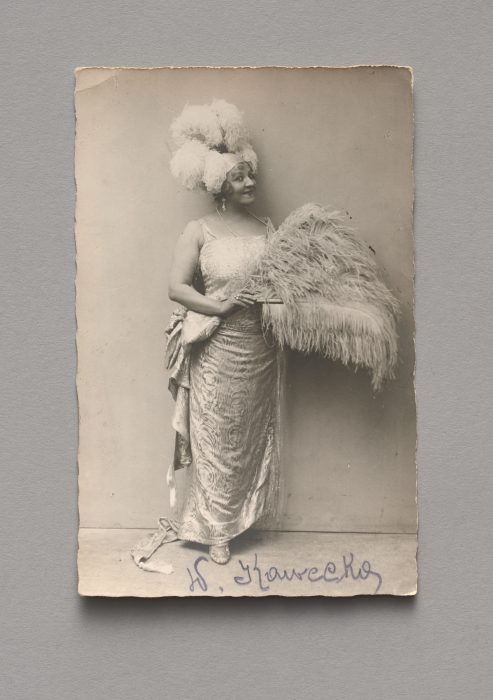
Postcard featuring the portrait of diva Wiktoria Kawecka (1875–1929)
Wiktoria Kawecka was hailed the “Nightingale of Warsaw” and “Queen of Diamonds”. The black and white postcard photograph presents her in an impressive dress and headdress, holding a feather fan.
The holdings of the Museum of Warsaw include several dozen postcards with images of actors and actresses bearing stronger or weaker ties to Warsaw. Kawecka was born and died in Warsaw, where she received vocal training, debuted on stage, and in 1898 went on to become a prima donna of the operetta of Warsaw State Theatres (WTR), a theatre institution operating in the years 1821-1915 under the Russian management. Her repertoire comprised both classical and popular pieces, sung in Polish and Russian.
She enchanted the audiences with the timbre, scale and power of her beautiful and perfectly trained voice. The singer also graced her performances with artistic whistling, yodelling and mormorando, as well as her own accompaniment. She often performed in other cities of the Russian Empire: Moscow, Kiev, Odessa and Kharkiv, especially after 1909, when the “Nowości” Theatre, one of the WTR stages, began to feature a younger singer Lucyna Messal, the legendary Messalka (1886–1953), who became her rival. Ultimately, Kawecka moved permanently to Saint Petersburg where she resided until 1919. In Russia, she met with great enthusiasm and enjoyed immense success. Her admirers showered her with flowers and diamonds. She owned a vast jewellery collection, and one of her admirers, Warsaw confectioner Edmund Gwizdalski (dates of birth and death unknown), presented her with a gift of the “Versailles” villa outside Warsaw which was adorned with medallions with her image, among other decorations (the villa has survived until today). Kawecka enjoyed travelling; her destinations included Monte Carlo where she relaxed while playing roulette. After World War I, she performed in Polish and European cities. She recorded many gramophone records for the famous Warsaw record label Syrena Record.
The singer was loved for her kindness and financial support which she generously provided to stage personalities. After she had died, her wealth was estimated at five million zlotys. Her heirs received a tenement house at 39 Hoża Street, which exists until the present day, furniture, full coffers, furs (one of them was estimated at 100,000 zlotys), jewellery, including a 52-carat diamond which fell prey to theft when it was put on sale. Fortunately, the police were quick to catch the thieves. Wiktoria Kawecka–Wielogłowska was buried at the Powązki Cemetery in Warsaw in a monumental grave adorned with a female statue by Bartłomiej Mazurek (1856–1937), a well-known selftaught sculptor from Warsaw.
The presented photograph was taken in the highly-regarded atelier of Leo Forbert (1880–1938) who specialised in portraits. In the following years, Leon or Leo Forbert, Polish photographer of Jewish decent, went on to gain repute as a film director and
producer, founder of the Leo-Film studio.
Postcard featuring the portrait of diva Wiktoria Kawecka (1875–1929)
PHOTO LEO FORBERT, PUBL. UNKNOWN
AFTER 1905
POSTCARD PHOTOGRAPHY
AI 5571
14 × 8,9 CM
Image licensed under: ![]()
